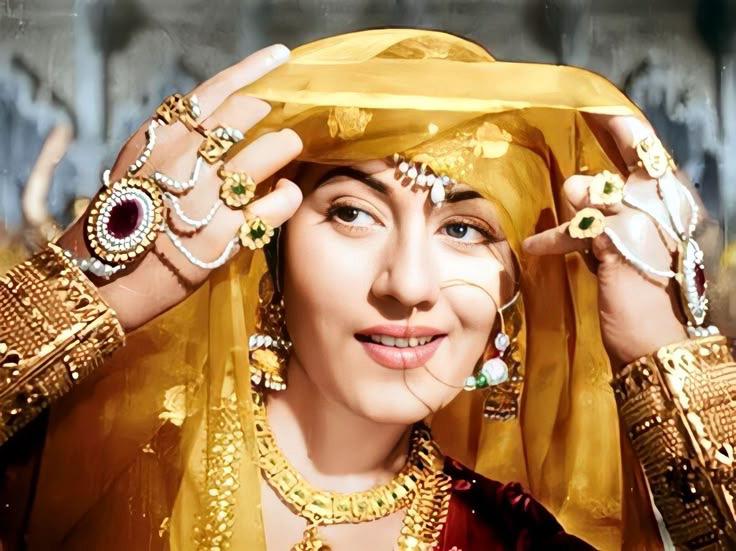Bollywood has been a powerful cultural force, influencing global fashion trends with its elaborate costumes, rich textiles, and ornate embroidery. Among the many styles that have stood the test of time – anarkalis, mirror work, and shararas remain timeless favorites. Interestingly, these old-school Bollywood fashion staples are making a strong impact on the Middle Eastern fashion scene, with regional designers seamlessly integrating these elements into their creations. This cross-cultural fusion has resulted in breathtaking ensembles that celebrate both South Asian heritage and Middle Eastern grandeur.
Anarkalis: The Regal Silhouette Finds a New Home

The anarkali, a classic floor-length, flared tunic with a fitted bodice, has been a Bollywood staple for decades – popularized by Mughal-era fashion through films like Mughal-e-Azam and Jodhaa Akbar.

Middle Eastern designers have taken inspiration from anarkalis and given them a unique, regional twist. A fusion of anarkali and the traditional kaftan, a much-loved garment in the Middle East – heavy embellishments align perfectly with the region’s penchant for intricately designed abayas and evening gowns. Fabrics like chiffon, silk, and organza enhance the elegance, while embroidery techniques such as zari, gota patti, and pearl work add a distinct Middle Eastern touch.
Mirror Work: A Dazzling Trend That Bridges Cultures

Mirror work, or shisha embroidery, originated in the Indian subcontinent and has been a defining element of Bollywood fashion. From the vibrant lehengas worn in 1970s films to contemporary red-carpet looks, mirror embellishments have always exuded glamour.
Middle Eastern designers are now incorporating mirror work into abayas, jalabiyas, and couture gowns, creating a unique fusion of Bollywood dazzle and Arabian sophistication.
 Modern abayas are being adorned with mirror work along the hemlines and sleeves, adding a Bollywood-style vibrancy to an otherwise subtle garment.
Modern abayas are being adorned with mirror work along the hemlines and sleeves, adding a Bollywood-style vibrancy to an otherwise subtle garment.
- Evening gowns featuring delicate mirror accents are gaining popularity, especially for weddings and festive occasions.
- The trend is also being seen in bridal wear, where subtle mirror detailing adds a dreamy, reflective quality to ivory and pastel-colored gowns.
Shararas: The Bollywood-Meets-Arabic Fusion
The sharara, a traditional South Asian outfit featuring wide-legged, heavily flared trousers paired with a short kurti, has been a Bollywood favorite since the 1960s and 1970s. Actresses like Rekha and Madhuri Dixit redefined elegance with these voluminous ensembles in films like Umrao Jaan and Devdas.

Middle Eastern designers are reimagining shararas with modernized cuts and Arabesque embellishments. The flowy, dramatic silhouette of the sharara aligns perfectly with the Middle Eastern love for voluminous gowns and abayas. Here’s how this Bollywood trend is being reinterpreted:
- Sharara-inspired gowns – Many designers are merging the sharara with the classic abaya and jalabiya to create an elegant, fusion look.
- Gold thread embroidery and beadwork – Shararas in the Middle East often feature gold, silver, and pearl embellishments, aligning with the region’s love for opulent detailing.
- Velvet, brocade, and silk fabrics – These luxurious textiles give the traditional sharara a Middle Eastern twist, making it perfect for weddings and gala events.

The growing influence of Bollywood fashion on Middle Eastern designers can be attributed as:
- Bollywood films have a massive following in the Middle East
- Both South Asian and Middle Eastern cultures celebrate intricate embroider and luxurious fabrics along with detailed craftsmanship
- Many Bollywood outfits naturally align with Middle Eastern preference for modest fashion
- B-town stars like Deepika Padukone, Kareena Kapoor Khan, and Aishwarya Rai Bachchan have often been spotted wearing Middle Eastern designers
(Contributed by Wajeeha Syed)

 Modern abayas are being adorned with mirror work along the hemlines and sleeves, adding a Bollywood-style vibrancy to an otherwise subtle garment.
Modern abayas are being adorned with mirror work along the hemlines and sleeves, adding a Bollywood-style vibrancy to an otherwise subtle garment.








